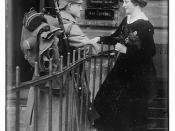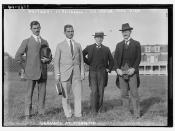Blitzkrieg Heading into 1939, Hitler knew that his every move was being scrutinized by the Allied powers and that all of his gradual violations of the Treaty of Versailles would eventually push his opponents over the edge. While the British had an obvious policy of appeasement, they could only allow Hitler to break so many rules. Nonetheless, Hitler wanted to capture Poland and Norway because he wanted to regain land taken from Germany by the Treaty of Versailles [www.spartacus.net]. Therefore, knowing that this action could set off the Allied Powers to declare war, Hitler knew he needed a swift and decisive attack on Poland that would send a message to his opponents. The resulting attack employed a new military tactic known as blitzkrieg.
Though many people attribute the strategy of blitzkrieg to Hitler or the German generals, it was actually invented around 1920 by Colonel John Fuller, the chief of staff of the British Tank Corps.
Fuller further developed his ideas in his books, Reformation of War (1923) and Foundation of the Science of War (1926). However, Fuller's ideas were ignored by the British, and thus studied a good ten years later by the German army. Realizing the potential of this strategy, the German commanders ordered the production of heavy artillery vehicles and tanks for possible use in later endeavors, a clear violation of the Treaty of Versailles. By 1933, Germany was open about its production of tanks. The famous Panzer followed soon thereafter in 1934 [www.spartacus.net]. Germany had now laid the groundwork for its military's future.
Blitzkrieg, literally translated as "lightning war"ÃÂ, was called by such a name because it was designed to be a very fast, decisive war, utilizing well-organized attacks from all fronts. Blitzkrieg was vastly successful because of two key characteristics. First, the use of a...


![[German vehicle tax registration issued to George Grantham Bain] (LOC)](https://s.writework.com/uploads/6/60390/german-vehicle-tax-registration-issued-george-grantham-bain-thumb.jpg)